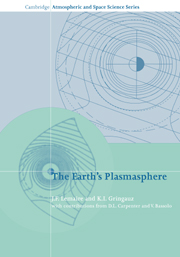Book contents
- Frontmatter
- Contents
- Preface
- Foreword
- Dedication
- Introduction
- Chapter 1 Discovery of the plasmasphere and initial studies of its properties
- Chapter 2 Electromagnetic sounding of the plasmasphere
- Chapter 3 Plasmasphere measurements from spacecraft
- Chapter 4 A global description of the plasmasphere
- Chapter 5 Theoretical aspects related to the plasmasphere
- Epilogue
- References
- Index
Chapter 1 - Discovery of the plasmasphere and initial studies of its properties
Published online by Cambridge University Press: 24 November 2009
- Frontmatter
- Contents
- Preface
- Foreword
- Dedication
- Introduction
- Chapter 1 Discovery of the plasmasphere and initial studies of its properties
- Chapter 2 Electromagnetic sounding of the plasmasphere
- Chapter 3 Plasmasphere measurements from spacecraft
- Chapter 4 A global description of the plasmasphere
- Chapter 5 Theoretical aspects related to the plasmasphere
- Epilogue
- References
- Index
Summary
Introduction
Until the early 1950s no one suspected that the ionosphere of Earth extends far into the geomagnetic field and forms what is now called the protonosphere. The discovery of this region, filled with low-energy charged particles of ionospheric origin, is an interesting one from a historical perspective. It started with the pioneering whistler wave investigations by Storey, and continued with the theoretical work of Dungey, who developed the idea of a Chapman–Ferraro cavity. Then, towards the end of the decade, the first in situ measurements of the high-altitude plasma and of a steep density dropoff at L ∼ 4 were made by Gringauz and his colleagues in the USSR. Meanwhile, Carpenter was beginning the series of whistler studies that led to the identification of what is called the ‘knee’ in the equatorial electron density profile, and eventually to the description of the worldwide structure and first-order dynamics of what he called the plasmasphere. The historical account of these early discoveries is not generally well known by the younger generation of space physicists; some of its aspects are unknown even to the older. Since it is interesting to record for future studies of the history of science the paths followed by the pioneers, we devote this first chapter to events that happened in the early days of the space age.
In reading what follows, one should realize that in the middle and late 1950s the world space physics community was small and widely scattered.
- Type
- Chapter
- Information
- The Earth's Plasmasphere , pp. 1 - 39Publisher: Cambridge University PressPrint publication year: 1998



